Butternut Squash Noodles
Updated Jun 12, 2021
Butternut Squash Noodles are a fun colorful low-carb pasta alternative that you can swap in your favorite noodle recipe or enjoy on their own as a side dish
This post may contain affiliate links. Please read our disclosure policy.
If you’re looking for a new low carb noodle option, try these Butternut Squash Noodles – a fun colorful swap for pasta. You can enjoy them simply seasoned with salt, pepper and butter or olive oil, or you can add a sauce to them like cauliflower alfredo or marinara. Once you make the zoodles, you can boil, sauté or oven-roast them for a delicious fall-inspired low-carb noodles.
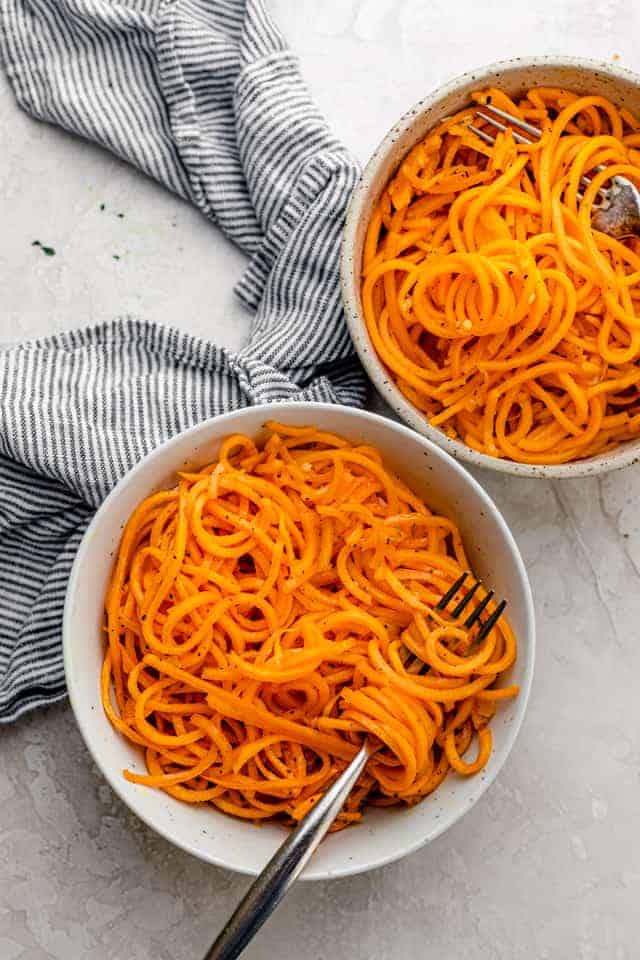
How to cut and peel butternut squash
Butternut squash is tubular in shape with a wide neck part that is seeded. You want to cut the butternut squash right where the shape changes from the tube to the wide neck. You can save that wide piece to peel, seed and chop and roast a later time.
As for the neck of the butternut squash, trim off the end so you can stand it upright on a cutting board, and use a knife or vegetable peeler to remove the skin. Now you’re ready to make noodles! And of all the vegetables, like zucchini noodles and sweet potato noodles that I’ve spiralized, butternut squash was the toughest one. And I think small handheld spiralizers may have a tough time doing the job.
I recommend using something strong and sturdy like the Paderno spiralizer or something similar. And, you want to use the thickest blade to push the butternut squash through the machine. This is the hardest part of the recipe, but if you keep the squash sturdy, it should only take you a couple minutes.
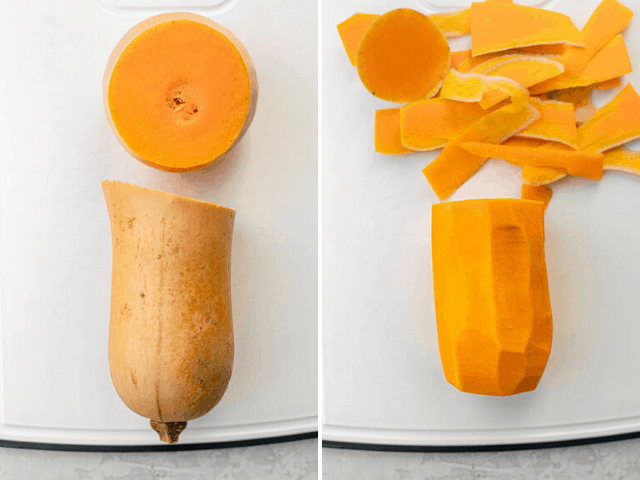
How to cook butternut squash noodles
Whether you make the noodles yourself, or you buy the butternut squash noodles already prepared, there are 3 ways to cook butternut squash noodles. You can boil on stovetop, sauté on stovetop or roast in the oven. You could also microwave the noodles, but I haven’t found that to yield the best texture.
Boil on stovetop
Boil the butternut squash noodles (like spaghetti) in a pot of salted boiling water for 2-4 minutes. This is my least favorite way, but it definitely works and it’s great if you already have a pot of boiling noodles or if you’re mixing half pasta and half noodles in one pot. Just be sure to keep an eye on the squash so it doesn’t soften too much.
Sauté on stovetop
First, sauté some aromatics with some fat. So you can use onions or garlic or both with olive oil or butter or other cooking oils. Then, add in the butternut squash noodles and sauté for 7-10 minutes, frequently tossing the noodles with tongs to make sure they’re evenly cooked. As they cook, they will shrink down in size and become softer.
You can then finish it off with fresh herbs, cheese or other add-ins like sun-dried tomatoes, roasted red peppers or olives etc.
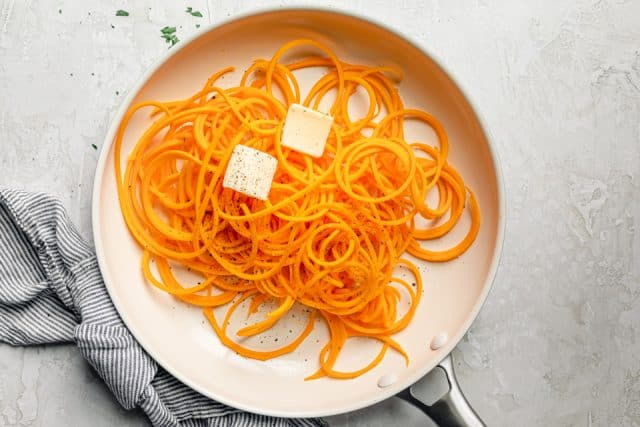
Roast in oven
Finally, the last cooking technique is to roast the butternut squash in the oven. I love roasting all root vegetables, and these butternut squash noodles are no exception. You can line a baking sheet with parchment paper, or just place them directly into a casserole dish with some seasoning and butter or olive oil. It takes only 10-15 minutes to roast the butternut squash noodles in the oven, depending on how soft you’d like them—a great hands-off approach! Be sure to toss halfway through.
I often choose the technique that I’ll cook the butternut squash depending on what else I’m serving it with as it’s a side dish. I prefer to sauté, for example, if I’m using the stovetop to cook noodles and shrimp to make pesto spaghetti. Or I might choose the roasting method if I’m serving them with oven-baked salmon.
Tips for making butternut squash noodles
- Use the long thin neck part of the butternut squash for spiralizing. The bottom part (where the seeds are), called bulbous, is not ideal for spiralizing, because of the uneven shape and the seeds in the middle.
- Don’t overcook the butternut squash noodles. Regardless what method you’re using to cook the noodles, keep an eye on them because the texture changes quickly and can become too soft. You’re looking for a fork tender consistency, where it’s easy to twirl the noodles without them breaking apart on the fork.
- Season while you cook; it will go a lot further than seasoning after. On their own, these butternut squash noodles can be bland. So seasoning them before you cook them will help bring out their sweet and nutty taste.

Frequently asked questions
What to do with butternut squash noodles?
- Use in a salad like my Asian Noodle Salad
- Add to spaghetti like in Spaghetti and Marinara
- Serve with side or protein and vegetables like I did with my Sweet Potato Noodles
- Make egg nests and bake or fry with eggs
What sauce goes with butternut squash noodles?
If you just want to eat the butternut squash noodles on their own, I recommend keeping it simple with the butter or olive oil, salt and pepper and parmesan cheese. But I think the sweet and nutty taste of butternut squash lends itself really well to a creamy sauce like Alfredo or a mushroom sauce.
Can I freeze butternut squash noodles?
Yes, you can freeze butternut squash noodles. But if you’re going to freeze them, I recommend doing so before cooking them. Squash retains a lot of water which can yield to a mushy consistency if frozen and thawed. To freeze the uncooked butternut squash noodles, simply place in a freezer-safe container or bag for up to 3 months.
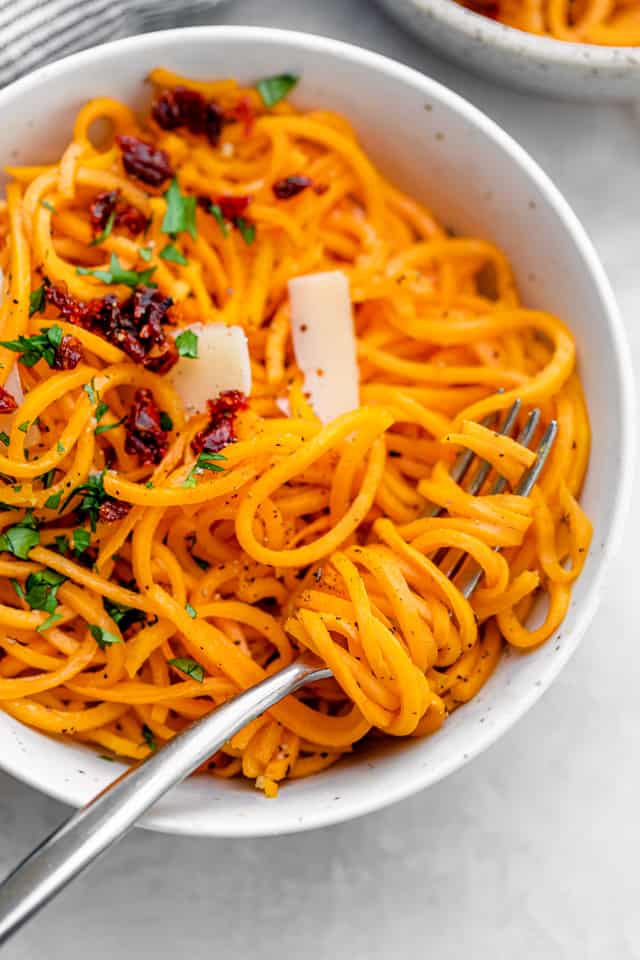
More squash recipes:
- Roasted Butternut Squash Soup
- Butternut Squash Risotto
- Butternut Squash Mac and Cheese
- Baked Butternut Squash Fries
- Kousa (Stuffed Squash)
More low-carb dinner recipes:
If you’ve tried this healthy-ish feel good Butternut Squash Noodles recipe or any other recipe on Feel Good Foodie, then don’t forget to rate the recipe and leave me a comment below! I would love to hear about your experience making it. And if you snapped some shots of it, share it with me on Instagram so I can repost on my stories!

Butternut Squash Noodles
Video
Ingredients
- 3/4 butternut squash spiralized
- 1 garlic clove minced, optional
- 2 tablespoons butter or olive oil
- 1 teaspoon Kosher salt
- ½ teaspoon black pepper
- Chopped parsley for serving
- freshly grated parmesan cheese for serving
Instructions
Stovetop Instructions
- Heat butter in a large saucepan over medium-high heat. Add garlic and cook until fragrant, about 30 seconds.
- Add the butternut squash noodles and cook for 5-7 minutes, depending on the thickness of your noodles, stirring occasionally with tongs until they are fork tender.
- Season the noodles with salt and pepper, grate parmesan cheese on top and sprinkle with fresh parsley, if desired.
Oven Instructions
- Preheat oven to 425°F. Place noodles on a large baking sheet. Add garlic, butter, salt and pepper, and roast until fork-tender and golden in spots—about 10-15 minutes, depending on how soft you'd like the noodles. Toss halfway through.
- Grate parmesan cheese on top and sprinkle with fresh parsley, if desired.
Notes
Nutrition
Nutrition information provided is an estimate. It will vary based on cooking method and specific ingredients used.
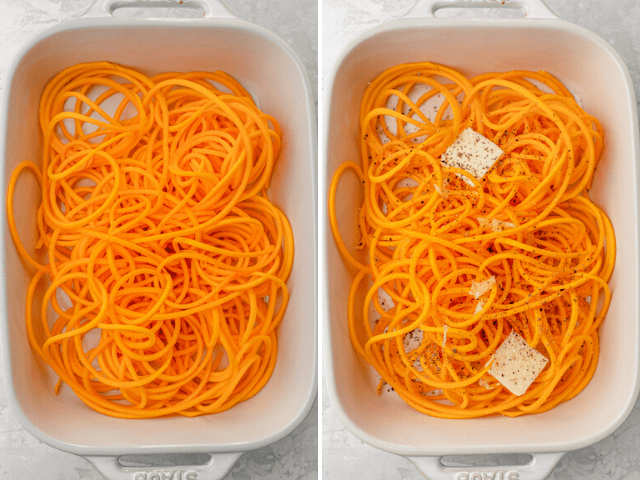






Comments
Idk, I tried baking the butternut squash spirals for 10 minutes at 425 and it was crunchy and definitely not cooked.
It sounds like your noodles needed some extra time in the oven. Did you roast them until fork-tender and golden in spots?
Thank you for this. I just bought some spiralized butternut squash from Sprouts and realized I wasn’t sure what to do with it. I’m curious about what your toppings are in your picture?
You’re so welcome! You can then finish it off with fresh herbs, cheese or other add-ins like sun-dried tomatoes, roasted red peppers or olives etc.
I purchased butternut squash noodles…..cooked them in boiling water for 5 minutes and they were still hard…..I ended up cooking the noodles for 20 minutes and still they retained their shape and did not soften as I had hoped. I wanted to mash them to create a casserole….I was disappointed.
Boiling the butternut squash noodles will still leave them with a little crunch. Was it the shape of the noodles? If it’s thicker, it may take longer to cook.
So Sorry You Did not know this before BUT one thing you can do Is if you take a few minutes to do this if you have a Rice cooker and were looking to do something -you can use the steamer basket and put some of them in there and steam them on the “Steam” setting for about whatever times you find works for whatever amount of noodles you put in there. Start with just enough to fill it and try for maybe 5- 8 minutes. and see if that gives you some tender ones. I have done zucchini this way and will be getting some of both kinds from our local Whole Foods tomorrow and trying this out in my oven. Hope this Helps you out if you try this. Have a Nice Day !
I sautéed these and they turned out perfectly. Thank you for all the tips and options.
That’s perfect! You’re so welcome!
Try Using 1 to 1 and 1/2 cups of water in the Rice cooker pot under the Steamer basket for your noodles .
Another fun low carb recipe. Love the nutty sweet taste of butternut squash. It will definitely be a repeat.